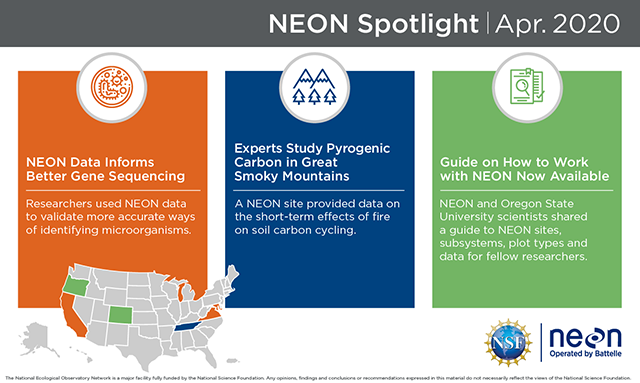April 2020: What’s New With NEON?

Data collected under the National Ecological Observatory Network (NEON) is proving its immense value in informing a diverse range of ecological studies. This month, we highlight a group of scientists that shared a new guide on best practices for using NEON data, and examples of studies that demonstrate NEON’s capability to advance ecological research.
This Month’s Spotlight
The latest news from the NEON project includes:
- Identifying microorganisms and defining their function within communities has historically been a challenging process due to a lack of centralized data. However, the NEON program affords researchers the ability to investigate ecological questions on a regional and continental scale and provides high-quality, integrated and standardized data from field sites across the United States. Using NEON data, Rita R. Colwell, Anwar Huq and Kyle D. Brumfield from the University of Maryland, James L. Olds from George Mason University, and Menu B. Leddy from Essential Environmental and Engineering Systems were able to validate whole genome shotgun sequencing (WGS) as a more accurate way of identifying microorganisms and putative functional genes.
- Rapid ecosystem changes after a wildfire make it difficult to study their effects. To overcome this, NEON researcher Michael SanClements, along with Drs. Jeff Hatten and Lauren Matosziuk from Oregon State University, Maggie Bowman and Jessica Egan from the University of Colorado, and researchers from the USDA Forest Service and Virginia Tech analyzed soil samples on a NEON site in Tennessee’s Smoky Mountains before and after a fire to better understand the short-term effects of fire on soil carbon cycling, specifically the mobility of pyrogenic carbon.
- As a platform for facilitating ecological research, NEON welcomes and encourages collaborations with the scientific community and provides a wide range of services and resources to aid in advancing ecological research. A team of researchers from NEON and Adrian Gallo from Oregon State University created a guide on how to best use NEON sites, subsystems, plot types and data for fellow researchers.
You can read about the latest research in the NEON Spotlight every month at Inside Battelle, and also on our social media channels. For more information about NEON, visit NEONscience.org.
BATTELLE UPDATES
Receive updates from Battelle for an all-access pass to the incredible work of Battelle researchers.